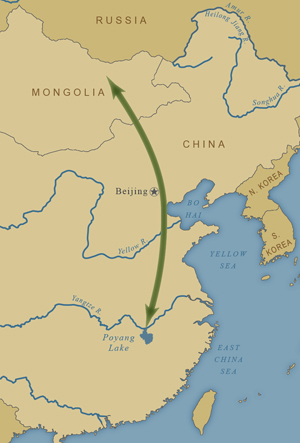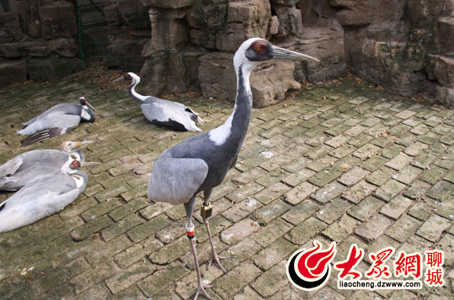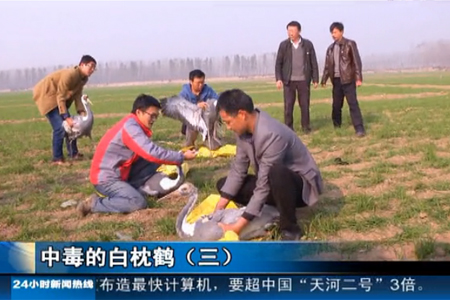 By Claire Mirande, Conservation Networking Senior Director
By Claire Mirande, Conservation Networking Senior Director
In August 2014, a team of scientists from the International Crane Foundation, Mongolian Wildlife Science and Conservation Center, Mongolian Academy of Sciences, and U.S. Forest Service traveled to the Khurkh and Khuiten River Valleys of northern Mongolia to study this important breeding area for White-naped Cranes. Part of the Mongolia expedition was to capture and band White-naped Cranes to study their long-distance migration to winter habitat at Poyang Lake in southern China (right). From these data, we further hoped to learn about the challenges and threats that the cranes encounter during their journey and identify habitats used by the birds and in need of protection.
Six cranes were banded with satellite or cellular transmitters during the summer expedition to the bird’s nesting grounds, and an additional 19 birds were marked with color leg bands. To symbolize the passion and commitment of the team of scientists and educators working on behalf of these cranes, each of the six birds with transmitters was given the name “Hope” in a different language spoken along their flyway.
As the banded cranes left their hatching grounds and began their sojourn south, scientists from Mongolia, China, and the U.S. watched the signals daily to track their progress. In late October, Andrew McGann, a colleague from Cellular Tracking Technologies working with us to design and adapt cell phone (GSM) transmitters for cranes, noticed that suddenly one of the signals was coming from within a village in eastern China and not the usual fields or wetlands in the countryside. Using satellite images, he traced the bird’s movements to a zoo, and he quickly alerted colleagues in the field. Jiao Shengwu, a Ph.D. student from Beijing Forestry University who was tracking the birds through China, quickly stepped in to check on the status of this bird.

- In late October, “Hope” and five other White-naped Cranes were found poisoned near Liaocheng, China. The cranes were unintentionally poisoned after feeding in a field planted with winter wheat seeds treated with pesticide. Hope’s leg bands, including a cellular transmitter, allowed researchers to locate and identify him among the injured cranes. Photo courtesy Liaocheng Dazhong News

We learned that six White-naped Cranes, including one of our banded birds, were poisoned in Shandong Province in eastern China after feeding on winter wheat seeds treated with pesticides, a farming practice commonly used in China. The farmers were concerned to find the poisoned cranes and quickly alerted the local authorities. Staff from Yanggu County Forestry Bureau in Shandong Province immediately went to the scene and took the cranes to a wildlife rescue station in Liaocheng for treatment. Sadly, one of the birds died prior to treatment. Another was kept in captivity with a broken toe. Fortunately, four recovered, including our banded Hope, and were released on November 11, 2014 near where they originally were discovered.
The time for planting winter wheat in Northern China overlaps with the migration period for White-naped Cranes and many other migratory birds. Seeds are often treated with pesticides. The farmland is very critical for migratory birds for feeding to restore energy reserves, but it is also a dangerous place due to the highly poisonous pesticide use. It is urgent, therefore, to resolve this threat for migrating birds.
In early December, we rejoiced when Hope and the other three poisoned cranes safely arrived at Poyang Lake, although they were about one month later than most other White-naped Cranes. Hope has been travelling around Banghu, one of the key lakes used by cranes in this critical wintering habitat. Our colleague Cheng Yachang, also from Beijing Forestry University, has been observing the movements and behavior of the banded birds during the winter months at Poyang Lake.
The flight of Hope provided important clues to the dangers that cranes may face during migration. There has been growing concern, but limited information, on both indirect and direct poisoning of cranes and other migratory waterbirds in China. The response and concern of the local people in Liaocheng provided a ray of hope that people will care, and that safer ways to protect seeds can be found that are less harmful to the environment, wildlife, and people. We are all on this journey together.
